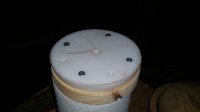Shawn Schiebrel
PRO Member
I was checking out the faceplates and was kinda stunned by the prices. Then I saw faceplate rings. As many of you know, these are steel rings that have holes that can be screwed into the scrap blocks, but have dove tail edges that are grabbed by standard chucks. These are even more expensive, so I thought, how hard can it be to make these. I thought about using wood, but the thinness and potential to crack along the grain pattern made me nervous. I couldn't make them out of metal, but I thought about HDPE (high-density polyethylene). so I stopped at GFS and bought a $15 HDPE cutting board that's about 1/2 inch thick and laid out 7 4" rings. Cut them out with a bandsaw and used the wormwood screw to mount it to the chuck. Turned it to the right size with a nice dovetail, then while on the lathe, scribed a line on the face about 2/3 between the center and the edge, took it off and drilled 8 countersunk holes on the scribed line. pretty happy with it. I've tested by attaching it to a pretty large blank and turning it. rock solid and pretty happy with it.

